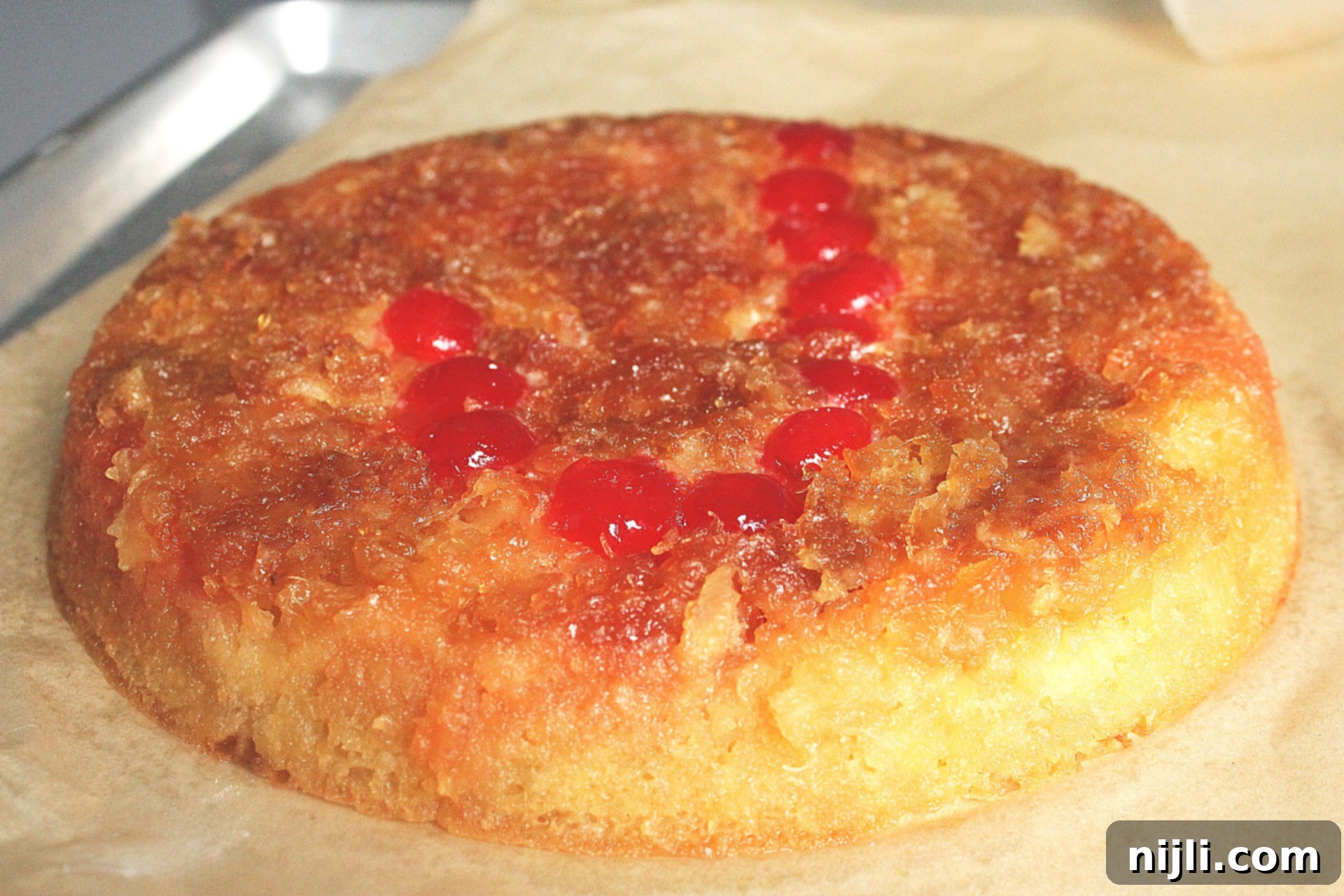Best Homemade Cast Iron Pineapple Upside Down Cake: An Easy & Classic Dessert
This easy pineapple upside down cake, baked to perfection in a cast iron skillet, is truly something special. If you’ve ever dreamt of creating a delicious, homemade cast iron skillet pineapple upside down cake from scratch, your moment has arrived! This recipe simplifies the process, making it accessible for bakers of all skill levels, and the results are consistently spectacular.

*This post contains affiliate links — as an Amazon Associate I earn from qualifying purchases. Please see my disclosure for details*.
If you’re a fan of classic dessert recipes that bring a smile to everyone’s face, then you’ll absolutely adore this cake. And if you’re looking for more delightful treats, be sure to try my Blueberry Cake Filling, my Vegan Gingerbread Loaf Cake, or my Pumpkin Pecan Dump Cake! Each offers a unique flavor profile but shares the same homemade charm.
The Nostalgia of Pineapple Upside Down Cake
For me, pineapple upside-down cake holds a special place in my heart, evoking warm childhood memories. It was my mom’s signature dessert, a vibrant, fun, and utterly delicious retro treat that, even today, stands the test of time. As I grew older and my passion for baking blossomed, it quickly became one of my go-to recipes. I used to rely on a yellow cake mix for its simplicity and consistent results, but this homemade, from-scratch version, baked in a cast iron skillet, is not only just as easy but also boasts an even more profound depth of flavor.
The inspiration for perfecting this recipe recently came from a friend, Jackie, who specifically requested a pineapple upside-down cake for her birthday. Knowing it’s one of my absolute favorite cakes to bake, it was an instant “yes!” The joy of sharing such a beloved dessert made the experience even sweeter.
Can You Bake a Cake in a Cast Iron Skillet? Absolutely!
The short answer is a resounding yes! And there’s no better introduction to skillet baking than this fantastic cast iron pineapple upside down cake. It’s incredibly simple to prepare, and the cast iron skillet truly elevates the dessert by helping the sugary topping caramelize beautifully and evenly. The consistent heat retention of cast iron creates an unparalleled golden-brown crust, making it an ideal choice for this type of cake. It’s a method I wholeheartedly recommend, transforming an already perfect dessert into something even more special, suitable for any celebration or simply a delightful weeknight treat.
Why Use a Cast Iron Skillet for Your Pineapple Upside Down Cake?
The traditional method for making a classic pineapple upside down cake involves melting butter directly in the bottom of the pan, layering it with brown sugar, pineapple, and cherries, and then carefully pouring the cake batter over the fruit. Once baked and inverted, this caramelized layer becomes the stunning, glistening topping, infusing the entire cake with a rich, buttery sweetness.
Using a well-seasoned cast-iron skillet takes this process to the next level. Cast iron excels at retaining and distributing heat evenly, which is crucial for achieving that deeply caramelized, slightly crispy, yet wonderfully gooey topping. It ensures the butter melts perfectly and the brown sugar transforms into a rich, golden syrup that coats every piece of fruit. This superior heat conduction guarantees a consistent bake and a more pronounced, delicious caramelization that a standard cake pan simply can’t match.
That being said, if a cast iron skillet isn’t available, this cake can certainly be made in a 9-inch cake pan. Just be sure to monitor the baking time closely towards the end, as the cooking characteristics might differ slightly. While a regular cake pan will still yield a tasty cake, the cast iron truly imparts a unique depth and texture that’s hard to beat. If you do opt for a regular cake pan, I’d love to hear how it turns out!
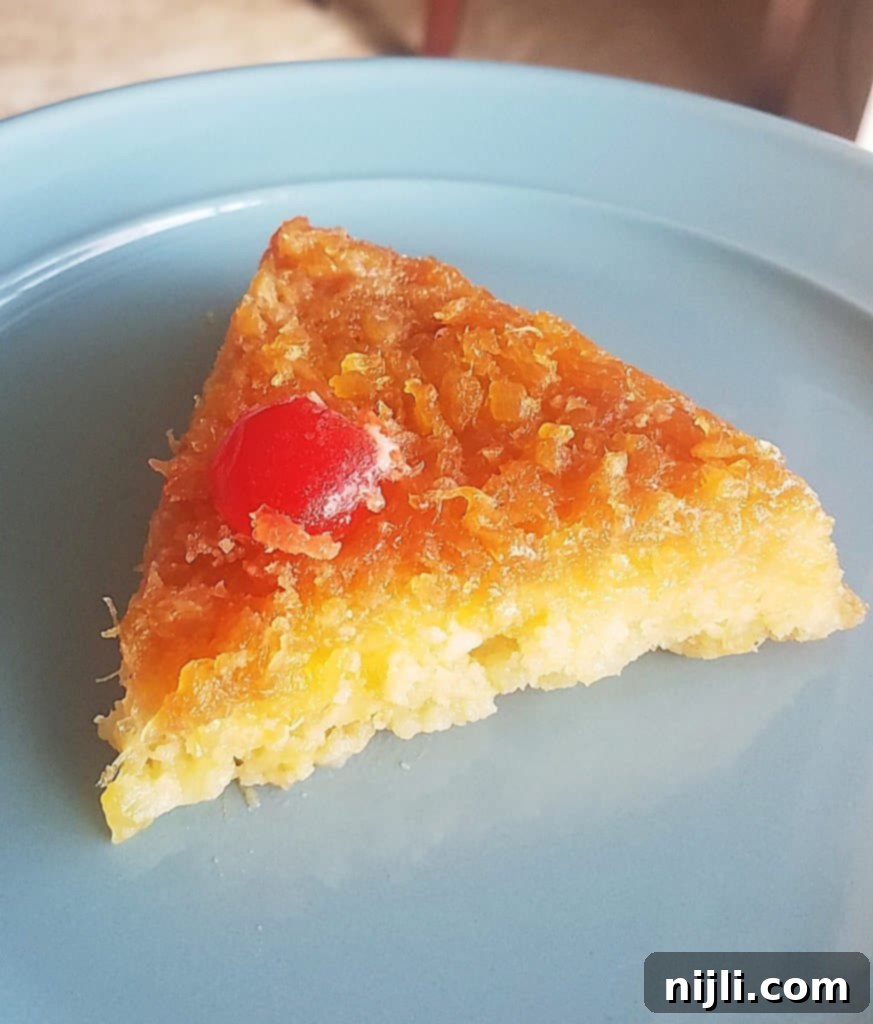
Ingredients for Your Perfect Pineapple Upside Down Cake
Crafting this delightful cake requires a selection of common pantry staples. You’ll find the complete measurements and detailed instructions in the recipe card below, but here’s a closer look at what you’ll need to have on hand, and why each ingredient is important:
For the Moist Cake Batter:
- Granulated Sugar: This provides the essential sweetness and contributes to the cake’s tender texture. For consistency, use a good quality granulated sugar.
- Large Eggs: Eggs are crucial for structure, moisture, and richness. Ensure your large eggs are at room temperature before mixing. If they’re cold, a quick 15-minute soak in lukewarm water will do the trick. Room temperature eggs emulsify better with other ingredients, leading to a smoother batter and a more uniform bake.
- Pure Vanilla Extract: For the most aromatic and authentic flavor, I always recommend using pure vanilla extract. You can even make your own vanilla for an extra special touch!
- Vegetable Oil: Oil is key for adding exceptional moisture to our skillet upside down cake, resulting in a wonderfully tender crumb. You can use any neutral-flavored oil like canola oil, vegetable oil, or avocado oil.
- Milk: I prefer using whole milk in all my baking recipes for its rich flavor and creamy texture. However, you can easily substitute it with low-fat milk or buttermilk if that’s what you have on hand or prefer.
- Reserved Pineapple Juice: Don’t discard the juice from your can of crushed pineapple! This liquid gold adds a burst of pineapple flavor directly into the cake batter, enhancing the overall tropical profile.
- All-Purpose Flour: The foundation of our cake’s structure. All-purpose flour provides the perfect balance, ensuring the cake holds together beautifully without being too dense or too crumbly.
- Baking Powder: This leavening agent is essential for giving our skillet pineapple upside down cake a beautiful lift and a light, airy texture.
- Salt: A small but mighty ingredient, salt is vital for balancing and enhancing all the other sweet flavors in the cake, making them truly sing.
For the Irresistible Caramelized Topping:
- Butter: I typically use salted butter for its depth of flavor, which complements the sweet pineapple beautifully. If you’re using unsalted butter, simply add a small pinch or two of salt to the butter as it melts to achieve a similar balance.
- Light Brown Sugar: The secret to that rich, golden caramel. Light brown sugar offers the perfect blend of sweetness and molasses notes, creating a complex and utterly delicious caramelized layer in this cast iron skillet pineapple upside down cake recipe.
- Crushed Pineapple: While traditional recipes often call for pineapple slices or rings, I find using crushed pineapple offers several advantages. It makes the cake much easier to slice and ensures you get a delightful burst of pineapple in every single bite! Remember to drain the pineapple thoroughly and reserve the juice for the cake batter.
- Maraschino Cherries: These vibrant red jewels add a pop of color and a touch of classic sweetness. Each maraschino cherry will need to be cut in half. For an even more sophisticated flavor, you could try using Luxardo cherries.
What is the Best Pan for Pineapple Upside Down Cake?
For this recipe, my top recommendation is a good-quality, well-seasoned cast iron skillet. A Lodge cast-iron skillet is an excellent and widely available option that performs beautifully. The cast iron’s ability to maintain and distribute heat evenly is unparalleled for achieving that perfect caramelized topping. While you can also use a 9-inch cake pan or a similar size skillet, be aware that you might need to adjust baking times slightly, typically a bit longer, in a standard cake pan.
Beyond the skillet, you’ll also need a few other basic tools: a rubber spatula for folding ingredients and scraping bowls, and a whisk or electric mixer for preparing the cake batter. A fine-mesh sieve is also helpful for sifting dry ingredients, ensuring a lump-free batter.
Pineapple Upside-Down Cake: A Simple Step-by-Step Guide
Making this incredibly delicious cake is easier than you might think! The super-simple batter is quite similar to my beloved spiced banana cake – another fantastic single-layer dessert.
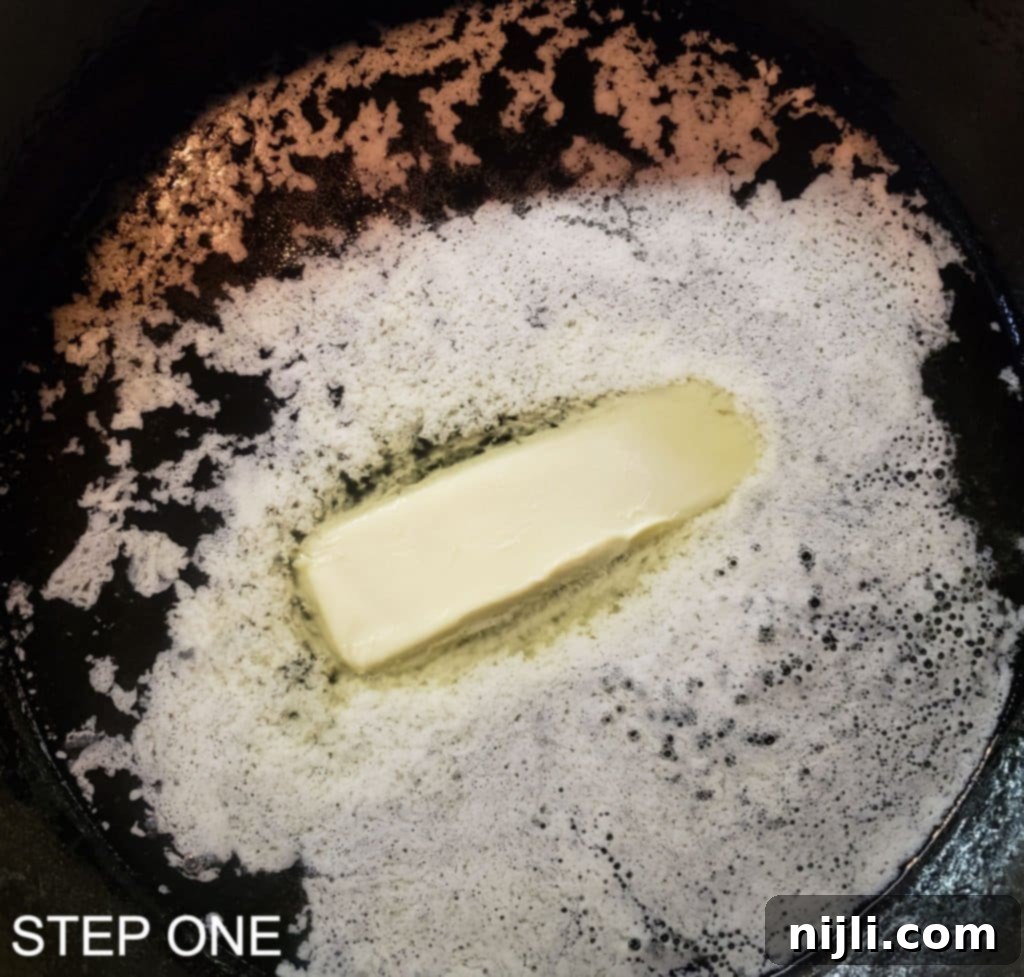
Once you’ve whipped up your beautifully smooth cake batter in a large bowl, it’s time to prepare the topping. You’ll start by melting butter directly in your cast iron skillet over medium heat on the stovetop. Watch it carefully to ensure it melts evenly without browning too quickly.
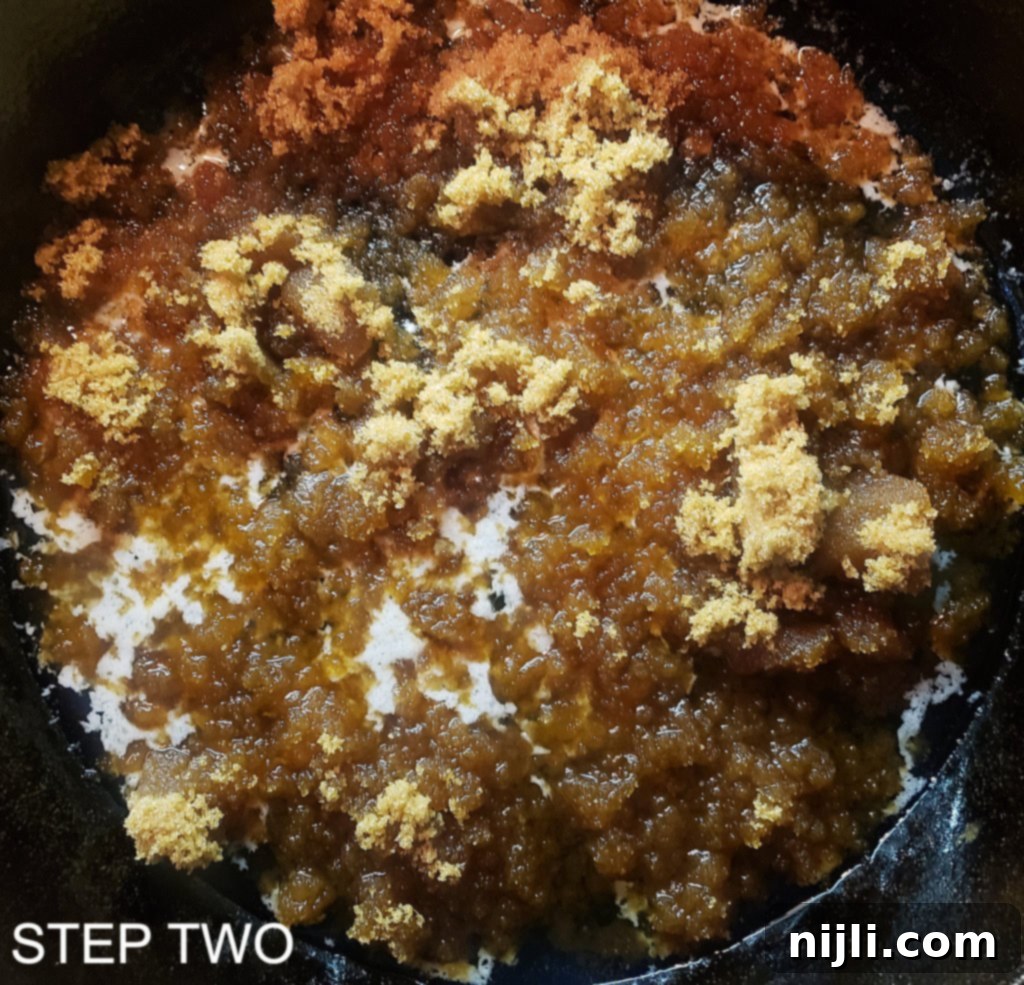
Next, evenly sprinkle the light brown sugar over the melted butter in the bottom of the skillet. This combination of butter and brown sugar is what will create that incredibly delicious, rich, and sweet caramelized topping once the cake is baked. Ensure it’s spread in an even layer to get uniform caramelization.
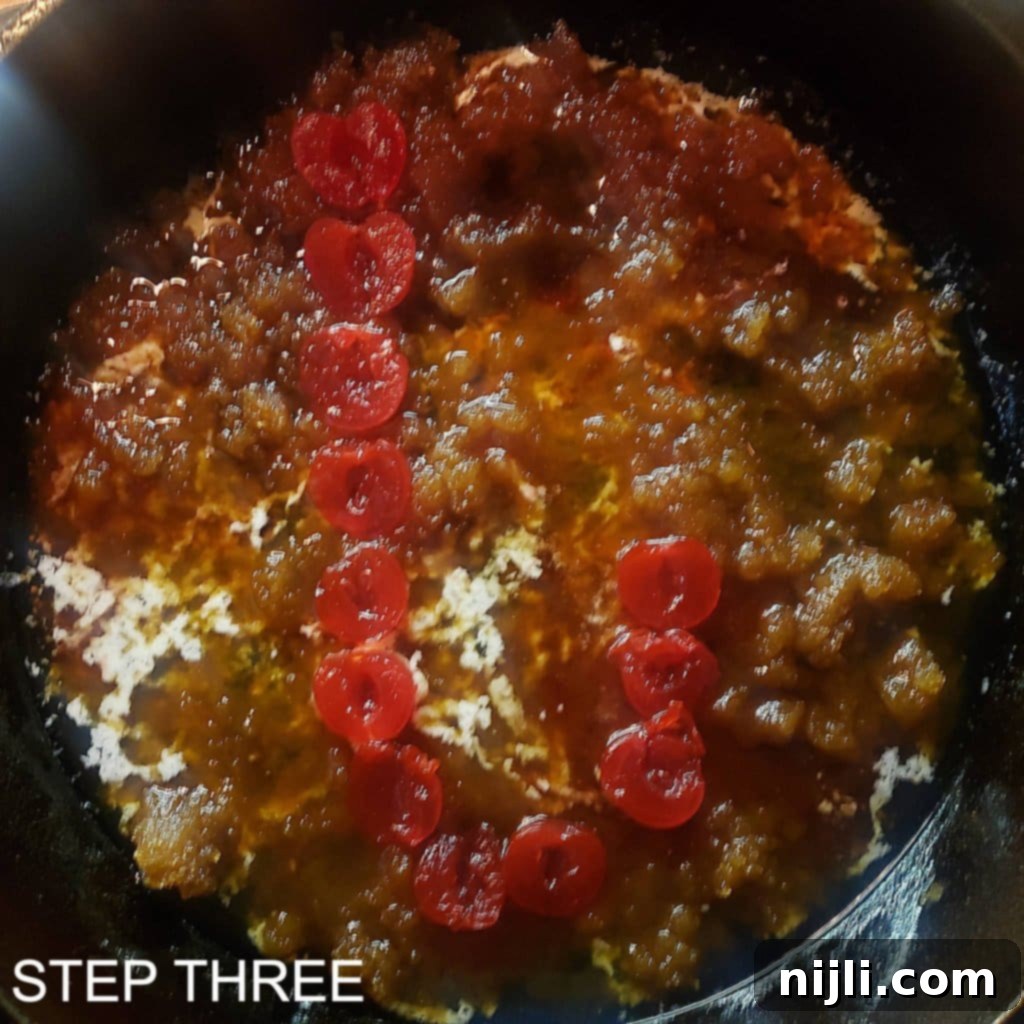
Now for the decorative touch! Place the cherry halves, cut side up, onto the brown sugar layer. Typically, you’d arrange them uniformly for a classic look, but I decided to get a little creative and arrange mine in a “J” pattern as a nod to my friend Jackie’s birthday. Feel free to unleash your own creativity with patterns or simple, even spacing.
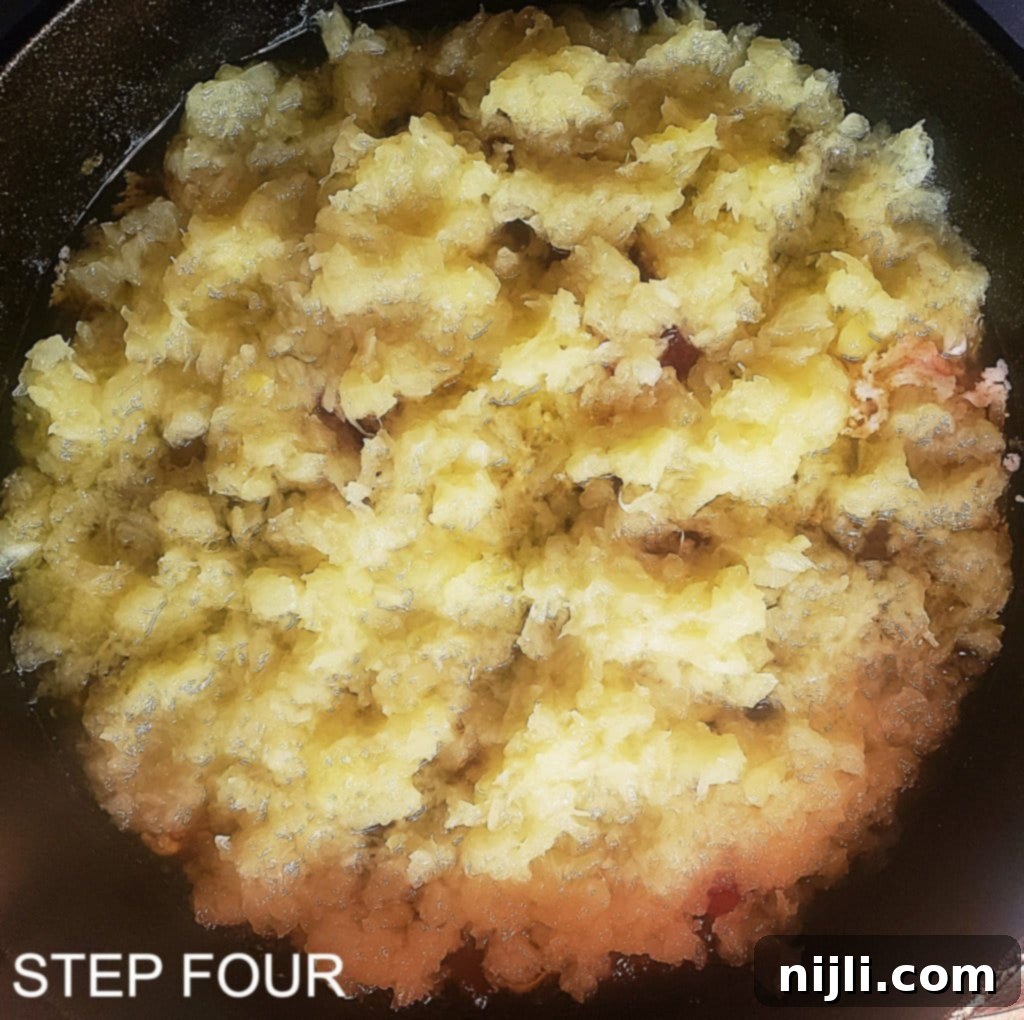
Once your cherries are perfectly placed, gently spoon the thoroughly drained crushed pineapple over the top. Remember, we used the reserved pineapple juice in the cake batter, so ensure the pineapple itself is well-drained to prevent a soggy cake. Pat it down lightly with the back of a spoon to create an even layer over the cherries and brown sugar.
You might notice this recipe specifically calls for crushed pineapple, which differs from many traditional pineapple upside-down cake recipes that feature pineapple slices or rings. This is a personal preference: I find that crushed pineapple integrates more seamlessly into the cake, making it incredibly easy to slice and ensuring you get a delightful burst of tropical flavor in every single bite! It also creates a more uniform topping that’s less prone to gaps.
However, the beauty of this recipe is its flexibility. The caramelization method remains the same whether you opt for crushed or sliced pineapple. If you decide to use pineapple rings, simply place your cherry halves in the center of each pineapple ring for that classic presentation.
The final, exciting step is to carefully pour the prepared cake batter over the pineapple layer in the skillet. Gently spread it to cover all the fruit evenly, then transfer your skillet to the preheated oven. Bake until the cake is golden brown and a toothpick inserted into the center comes out clean. The aroma filling your kitchen will be pure bliss, signalling the best pineapple upside down cake you’ve ever made is almost ready!
Cast Iron Pineapple Upside Down Cake with Rum: A Boozy Twist!
For those who appreciate a touch of spirited indulgence in their desserts, adding a hint of rum to this pineapple upside down cake is an absolute game-changer! I completely understand the desire for that extra kick; after all, my Rum Pound Cake and my Eggnog Bread Pudding with Brown Butter Rum Sauce are two of my all-time favorite recipes for a reason!
Adding rum is incredibly simple: just replace half of the pineapple juice in the cake batter with a good quality dark rum. Additionally, after you’ve spread the crushed pineapples over the cherries, sprinkle about a tablespoon of dark rum directly onto the topping before pouring the cake batter. This two-pronged approach ensures a delicious rum flavor infused throughout the cake and an enhanced caramelized topping. The warmth and complexity of the dark rum perfectly complement the sweet, tangy pineapple and rich caramel. It’s an easy modification that yields incredibly sophisticated results.

Frequently Asked Questions (FAQs)
The moist, caramelized topping is indeed a signature feature of this cake! The natural juices from the pineapples and cherries, combined with the melted butter and brown sugar, create that desirable luscious, slightly soft topping. If you find it excessively soggy, it could be due to a few factors: perhaps the pineapple wasn’t drained thoroughly enough, or maybe the cherries were very juicy. To prevent too much moisture, make sure to drain your crushed pineapple very well – you can even gently press out excess liquid. Pat your cherry halves dry with a paper towel before arranging them. A well-baked cake should still have a firm, moist crumb beneath the topping.
Yes, but with this cast iron skillet method, it’s slightly different from a traditional cake pan. When making the caramelized topping, your first step is to melt butter directly in the pan. This butter, combined with the brown sugar, creates a non-stick, flavorful layer. Therefore, you won’t need to separately grease the pan with cooking spray or butter and flour before adding the topping ingredients. A light spray with cooking spray at the very beginning ensures maximum non-stick properties, especially if your skillet isn’t perfectly seasoned.
The key to a successful flip lies in timing and technique! Luckily, baking in a cast iron skillet with a handle makes this process quite manageable. First, immediately after removing the cake from the oven, run a thin knife or offset spatula around the very edge of the warm cake, separating it from the skillet sides. Next, carefully place a large, heat-proof serving plate, a sturdy wire rack, or a platter upside down over the top of the skillet. With oven mitts protecting your hands, firmly hold both the skillet and the plate/rack together, and in one swift, confident motion, invert them so the skillet is now on top. Give the skillet a gentle shake, and the cake, with its beautiful caramelized topping, should release cleanly onto your serving surface. If any fruit sticks, simply use the knife to gently scrape it off and place it back onto the cake.
No, quite the opposite! It’s crucial to flip an upside-down cake while it’s still warm, typically about 10 minutes after removing it from the oven. If you wait too long for the cake to cool completely, the caramelized brown sugar and butter topping will harden and solidify, making it much more difficult to release from the pan. Flipping it while still warm ensures the sugar is still in a liquid or semi-liquid state, allowing the gorgeous topping to easily separate from the skillet and adhere perfectly to the cake.
Yes, due to the fruit topping, it’s best to store any leftover pineapple upside down cake in an airtight container in the refrigerator. This helps maintain its freshness and prevents spoilage. However, for the absolute best flavor and texture, I recommend allowing individual slices to come to room temperature before serving. Alternatively, a quick 15-30 second warm-up in the microwave can gently soften the cake and bring out its delicious aromas.
While canned pineapple is convenient and provides consistent moisture, you can certainly use fresh pineapple. If using fresh, ensure it’s very ripe for the best sweetness. You’ll need to finely chop or crush it, similar to the canned version. Also, you’ll need to use a substitute for the pineapple juice in the batter, such as orange juice or milk, as fresh pineapple juice can sometimes react with dairy, making the cake curdle or become too soft. Be sure to pat fresh pineapple very dry to avoid excess moisture.
Top Tip for Perfect Baking
For the very best, most consistent results every single time, don’t forget the golden rule of baking: measure your flour by weight with a kitchen scale! This simple step ensures accurate measurements, preventing your cake from becoming dense, dry, or inconsistent. Volume measurements (cups) can vary widely depending on how the flour is scooped, but weighing it guarantees precision for a beautifully tender and moist cake.
Related Recipes
- Passionfruit Tart with Almond Crust
- Skillet Blueberry Cobbler with Smoked Sugar
- Earl Grey Lavender Cake with Honey-Lemon Glaze
- Mango Overnight Oats
If you try this recipe, I would love it if you could leave a star review rating and comment below! It’s so wonderful hearing your feedback and seeing your creations! And don’t forget to share your delicious results with me by tagging @chenee_today on Instagram!
📖 Recipe
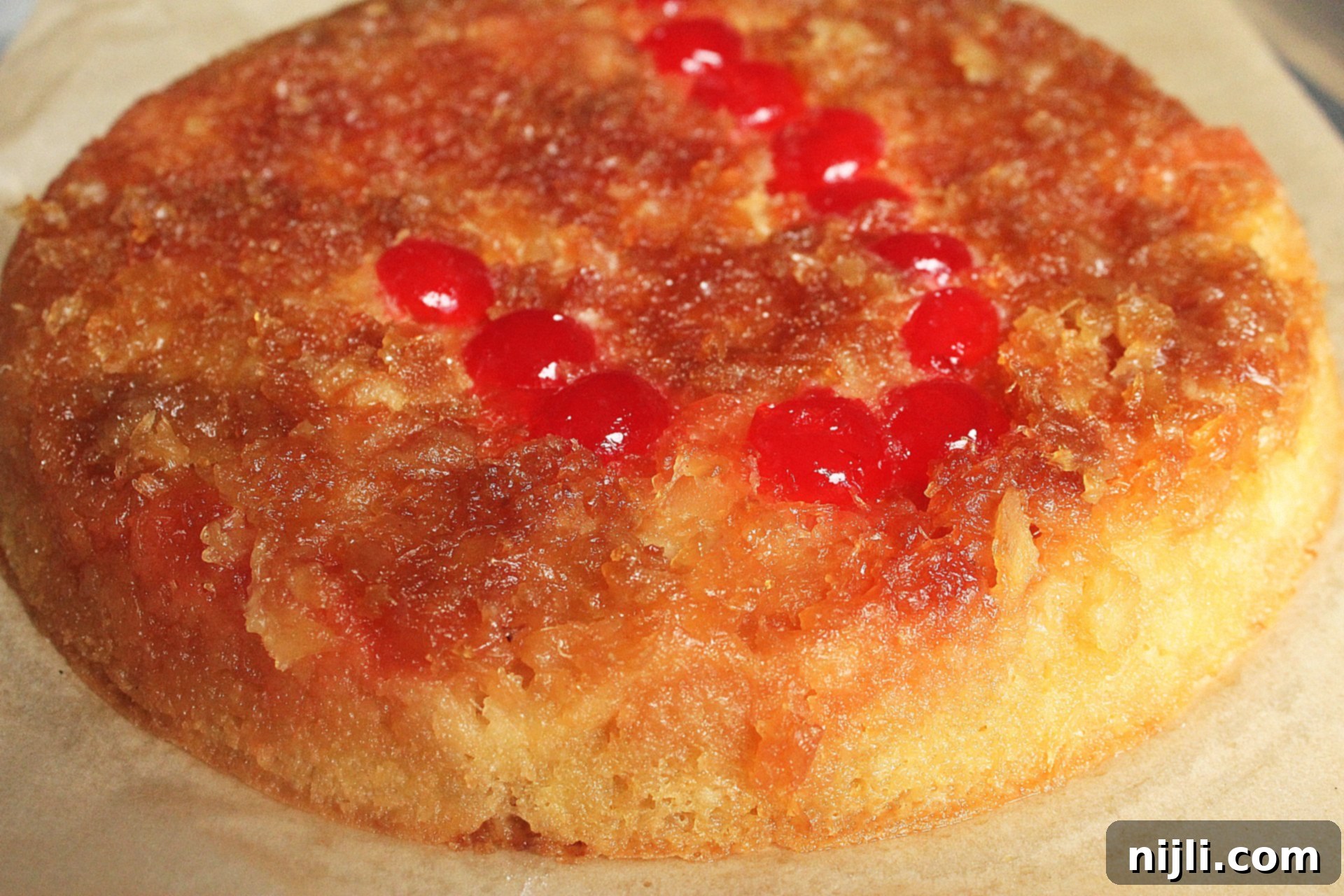
Pineapple Upside Down Cake in Cast Iron Skillet
Pin Recipe
Rate Recipe
Save RecipeSaved!
Equipment you may need
-
10-inch cast-iron skillet
-
Mixing Bowls
-
Measuring Cups and Spoons
-
Whisk
-
Fine Mesh Sieve
-
Rubber Spatula
Ingredients
For the Cake:
- ⅔ cup granulated sugar
- 2 large eggs – room temperature is key for a smooth batter
- 1 teaspoon pure vanilla extract – for the best flavor, homemade is even better!
- ⅓ cup vegetable oil – or any neutral-flavored oil like canola or avocado oil
- ½ cup whole milk – whole milk for richness, or substitute low-fat milk or buttermilk
- ⅓ cup pineapple juice – reserved from the can of pineapple
- 1 ½ cups all-purpose flour – measured by weight for accuracy
- 1 ½ teaspoons baking powder – for lift and a tender crumb
- ¼ teaspoon salt – enhances all the flavors
For the Topping:
- cooking spray – a little extra insurance for a clean flip
- 6 tablespoon salted butter – or unsalted butter with a pinch of salt
- ⅔ cup light brown sugar – for that classic, rich caramel flavor
- 20 oz crushed pineapple – drained very well, with ⅓ cup juice reserved for the cake batter
- 10 maraschino cherries – cut in half, or use Luxardo cherries for a gourmet touch
Instructions
-
Preheat your oven to 350°F (175°C). Lightly spray an 8 or 10-inch cast iron skillet with cooking spray for extra non-stick insurance. (A 9-inch round cake pan can be used as an alternative, see notes for details).cooking spray
-
In a large mixing bowl or the bowl of a stand mixer, combine the granulated sugar, room temperature large eggs, and pure vanilla extract. Beat these ingredients together for approximately one minute until the mixture is light, creamy, and well combined.⅔ cup granulated sugar, 2 large eggs, 1 teaspoon pure vanilla extract
-
To the wet ingredients, add the vegetable oil, whole milk, and the reserved pineapple juice. Stir everything together thoroughly until completely mixed.⅓ cup vegetable oil, ½ cup whole milk, ⅓ cup pineapple juice
-
In a separate bowl, whisk together the all-purpose flour, baking powder, and salt. Sift these dry ingredients directly into the wet batter. Using a rubber spatula, gently fold the dry into the wet until just combined. Be careful not to overmix, as this can lead to a tough cake. Set the batter aside while you prepare the topping.1 ½ cups all-purpose flour, 1 ½ teaspoons baking powder, ¼ teaspoon salt
-
On your stovetop, melt the salted butter over medium heat directly in your prepared cast-iron skillet. Ensure the butter is fully melted and covers the entire bottom surface of the pan.6 tablespoon salted butter
-
Evenly sprinkle the light brown sugar over the melted butter in the skillet. Using the back of a spoon, gently spread and lightly pat down the brown sugar to create an even layer. Then, artfully arrange the cherry halves (cut side down) on top of the brown sugar layer. Get creative with your pattern or simply space them evenly.⅔ cup light brown sugar, 10 maraschino cherries
-
Gently spoon the thoroughly drained crushed pineapple over the cherries, ensuring full coverage. Use the back of a spoon to lightly pat and distribute the pineapple evenly across the topping.20 oz crushed pineapple
-
Carefully pour the prepared cake batter into the pan, spreading it gently over the pineapple layer until it’s evenly covered. Transfer the skillet to your preheated oven and bake for approximately 30-35 minutes, or until a wooden toothpick inserted into the center of the cake comes out clean.
-
Once baked, remove the cake from the oven and allow it to cool in the pan for about 10 minutes. This crucial cooling period allows the caramel to set slightly but remain liquid enough for a clean release. After 10 minutes, carefully run a knife around the edge of the cake to loosen it. Place a large, heat-proof serving plate or wire rack over the skillet and, using oven mitts, invert the cake and skillet together onto the plate. If any pineapple or cherry sticks to the pan, simply scrape it off with your knife or spatula and gently place it back onto the top of the cake. Slice and serve warm!
Notes
Storage Tips: If you have any delicious leftovers, I highly recommend storing them in an airtight container in the refrigerator due to the fresh fruit topping. For the best enjoyment, allow each slice to come to room temperature before serving, or gently warm it in the microwave for a few seconds to revive that fresh-baked warmth and gooey topping.
Cast Iron Pineapple Upside Down Cake with Rum: For an adult-friendly twist, infuse your cake with a touch of rum! My Rum Pound Cake and my Eggnog Bread Pudding with Brown Butter Rum Sauce are testament to how well rum pairs with desserts!
To make this delightful variation, simply replace half of the pineapple juice in the cake batter with dark rum. Additionally, after you’ve layered the pineapples in the skillet, sprinkle an extra tablespoon of dark rum directly over the fruit topping before adding the cake batter. This will give your cake a wonderful, subtle boozy kick that complements the tropical flavors beautifully.
Nutrition
Nutrition Disclaimer
